
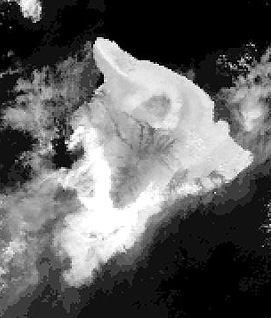
Oceanographic Observations
We now transit from emphasis on weather systems as seen from space
to concentrate on observations of the Earth's oceans. Most of
the information, however, to be reported next comes from metsats,
although several satellites, and a few Shuttle missions, were
intended to be oceanographic in scope. The kinds of knowledge
achieved by the sensors include: sea surface temperature, oceanic
current patterns, formation of eddies and rings, upwelling, surface
wind action, wave motions, ocean color (in part indicative of
phytoplankton concentrations), and sea ice status in the high
latitudes.
Coastal and shelf waters adjacent to continental margins generally
show considerable variation in near-surface temperatures. Some
of this is due to inflow and mixing of river waters but ocean
currents and upwelling modify the patterns. Look at the two thermal
IR images, made from NOAA AVHRR data, of part of the California
coastline from Mendocino south to Lompoc (top) and the big Island
of Hawaii (bottom), in which offshore warmer waters are displayed
in lighter tones.


Ocean currents, such as the Gulf Stream off the eastern U.S. Coast
and the Pacific current off the West Coast, result from redistribution
of warm water piling up in tropical regions towards cooler zones
at higher latitudes. A color-coded rendition (below, top) of part
of a Day-Thermal HCMM image (see Section 9) shows the well-defined
Gulf Stream off the North Carolina-Virginia coast. Paired with
this image is one of the East Coast showing surface temperatures
calculated from algorithms that process multi-channel data obtained
by, in this case, NOAA-14s AVHRR.

This second image also shows the Gulf Stream, which in places
has been broken into warm core rings, i.e., meanders in the current
that have pinched off (cold core rings also occur). Temperature
values for the colors include: orange = 25-28° C (77-82° F); yellow
= 23° C (72° F); green = 14° C (57° F); blue = 5° C (41° F).
Global satellite observations of temperatures in marine waters
(known as Sea Surface Temperature or SST) are now procured routinely
every day from data provided mainly by metsats. Here for example
is a "map" of SST made in late September of 1987.
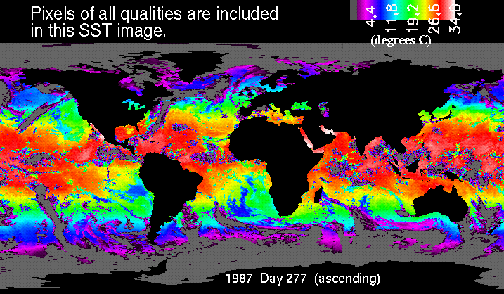
SST values can be integrated into calendar intervals and thus
compared month by month or between equivalent periods in years.
Below are SSTs for the months of January (top) and July (bottom)
in 1993, as determined from NOAA AVHRR data.
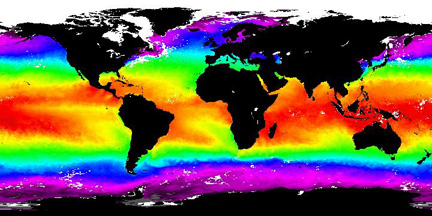
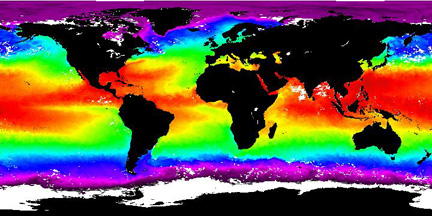
Again, reds and yellows show warm and blues and purples cold.
At first glance there does not seem to be much seasonal variation
judged worldwide, although close inspection reveals real differences.
In general, the oceans tend to maintain their average temperatures
with notably less variations than the atmosphere to which they
are coupled.
El Niño
Satellite observations were instrumental in identifying and understanding
the "El Niño" weather phenomenon. El Niño (the term [Spanish for
"the little child"] refers to its occurrence in the southern hemisphere
around Christmastime) results from changes in atmospheric pressures
in the eastern Pacific ocean that cause a reversal in the normally
westward flowing trade winds which in turn diminishes or reverses
an upwelling of cold water off the South American coast and displaces
the Peru current. The surface waters there become warmer (as much
as 8° C [14° F]) leading to increased southern summer storm activity.
In North America, an El Niño can greatly perturb normal weather
patterns, causing abnormal rainfall in some parts of the country
and droughts elsewhere. Ferocious storms are more frequent and
hurricanes may increase or decrease from normal numbers, depending
on effects in both the Atlantic and Pacific Oceans. An El Niño
is usually followed by a La Niña, essentially a reversal of conditions
off the western South American coast in which colder water than
usual is brought surfaceward.
The overall El Niño condition was particularly active in the early 1980s, Experts in early 1997 predicted a very strong El Niño condition for the latter half of that year into 1998. It's disaster phase may have started in 1997 with Hurricane Pauline on October 9, the strongest to hit the west Mexican coast in decades (devastating Acapulco), as suggestive evidence; events into January 1998 bear out the forecast, with heavy rainfall in the South and West, ice storms in New England and Canada, and abnormal balmy weather in some places.
This onset of marine warming, in fact, is strongly hinted at by
this Topex/Poseidon image taken on September 20, 1997 which shows
a broad, elongate band of very hot water stretching westward from
Peru across the Pacific.
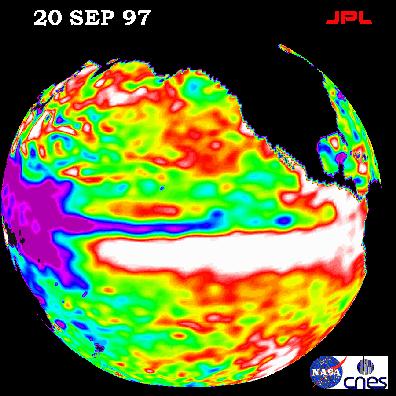
The next image pair show both the observed SST between Australia
and South America during January of 1983 and a prediction of the
expected temperature distribution based on 12 months of earlier
observations. The close correspondence between these two El Niño
data sets implies that even then the model explaining this phenomenon
had become "fine-tuned".
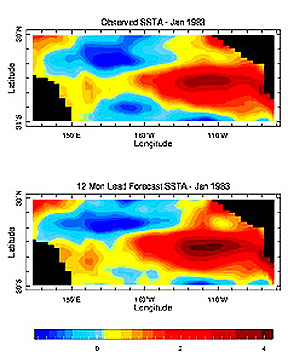
Below are four plots of SST from October into November of 1994,
showing the progressive shift of warmer waters to the east.
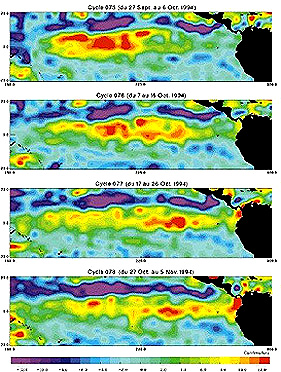
Although regional in extent, this perturbation can have a decided influence on weather over much of the Earth, as the conditions in the western Pacific also become disturbed.The combination of warm Pacific Ocean temperatures and shifts in the atmospheric jet streams means that certain areas in different parts of the world with typically dry conditions will instead get heavy rain and potential flooding, while other regions can be drought-stricken. An El Niño occurs every two to seven years, reversing normal weather patterns throughout areas of Canada, the United States, Mexico, South America and as far away as Africa. The last major El Niño occurred in late 1991 through mid-1992, with a smaller and less destructive El Niño recorded in 1994-95. The weather system can last as long as 18 months, depending on how rapidly the ocean temperatures cool down and return to normal. That El Niño is having a profound on global weather systems is supported by the recent summary of 1997 worldwide temperatures: that year has been the warmest 12 months in terms of average temperature maxima since records for the entire Earth were started in 1860; some of this may also reflect a significant contribution from global warming
As the summer of 1998 moved into fall, with several major hurricanes including
Mitch which killed more than 10000 people in Honduras and neighboring Central
American countries, a transition began in which the earlier El Niño gradually
changed into a La Niña. By mid-October the central band of cold water
had largely replaced the equatorial warm water, setting up the conditions associated
with a La Niña, as shown in the Topex/Poseidon illustration below. The
purple band denotes cooled (contracted) water some 18 cm (7 inches) below normal
heights.
At present there is an excellent Web site sponsored by NOAA that offers an overview of El Niño and daily to monthly reports on its stage of development and related activities. You can access this site through the link NOAA-El Nino. Data on El Niño as monitored by Topex-Poseidon (see next page) can also be accessed through a JPL site.
Code 935, Goddard Space Flight Center, NASA
Written by: Nicholas M. Short, Sr. email: nmshort@epix.net
and
Jon Robinson email: Jon.W.Robinson.1@gsfc.nasa.gov
Webmaster: Bill Dickinson Jr. email: rstwebmaster@gsti.com
Web Production: Christiane Robinson, Terri Ho and Nannette Fekete
Updated: 1999.03.15.